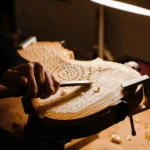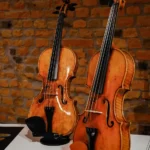Discover Guadagnini Violins: Prices, History, and More
Back to BlogGuadagnini Violins: Meet Giovanni Battista Guadagnini
In the world of violin craftsmanship, few names shine as brightly as Giovanni Battista Guadagnini. An 18th-century master luthier, Guadagnini’s artistry and precision have left an enduring mark on the violin-making tradition.
For musicians, collectors, and lovers of classical music, the name “Guadagnini” carries immense prestige. These violins are celebrated for their warm, resonant tones and playability, favored by virtuosos and revered for their contribution to the world of music.
Join us on a journey to explore the history, pricing, and unique qualities of Guadagnini violins. From their rich heritage to their place in the modern market, discover why these instruments remain a symbol of exceptional craftsmanship and timeless music.
Giovanni Battista Guadagnini: The Master Luthier
To truly understand the legacy of Guadagnini violins, we must first acquaint ourselves with the visionary craftsman behind them—Giovanni Battista Guadagnini. Born in 1711 in Piacenza, Italy, Guadagnini embarked on a journey that would forever alter the violin-making world. His life and career were marked by an unrelenting pursuit of perfection, resulting in some of the most exquisite violins the world has ever seen. His early labels show he was an apprentice of his father, Lorenzo; however, there is no clear proof that his father ever made violins. o, his debut in the violin-making world if unknown. His early instruments are dated from 1740, and he spent almost half of his life making violins (around 44 years).
Evolution of Guadagnini’s Violin-Making Style
Over his lifetime, his violin-making style and techniques underwent remarkable transformations. From his early years in his native Piacenza to Cremona, Milan, and his later ventures in Turin, Guadagnini’s instruments display a remarkable versatility, each marked by its unique character and tonal qualities. His cellos are highly admired. His innovations in cello-making were encouraged due to his relationship with the cellist Carlo Ferrari. He followed Carlo throughout his career journey, which led his work to be divided into four periods, corresponding to the places he had lived (Piacenza, Milan, Parma, and Turin), and each one of these periods has its own characteristics and style.
Historical Moments and Milestones
The legacy of Guadagnini violins is punctuated by key historical moments and milestones. One of the most important was his collaboration with Count Cozio di Salabue, the famous 18th-century collector. Cozio became his patron and commissioned many of Guadagnini’s finest works. Their close relationship allowed Guadagnini to familiarize and deeply study the works of Stradivari. The chronicles of these instruments are intertwined with the great musicians and collectors who recognized their exceptional value.
The Authenticity of Guadagnini Violins
Guadagnini violins possess a set of distinctive features that differentiate them from other instruments. These include the violin’s body shape, varnish, scroll design, and label characteristics. Understanding these unique traits can be instrumental in authenticating a Guadagnini violin. These instruments are cherished not only for their beauty but also for their historical significance.
Beyond their visual attributes, Guadagnini violins are celebrated for their captivating sound quality and tonal characteristics. Musicians are drawn to these instruments for their warm tones that resonate with depth and clarity.
It’s worth noting that while Guadagnini violins hold a distinct place in the world of violin-making, they are often compared to other renowned makers like Stradivari and Guarneri. Each has its own distinct charm, and understanding the differences can deepen one’s appreciation for these exceptional instruments.
Guadagnini Violin Prices: Factors and Trends
Guadagnini violins, with their storied history and exceptional craftsmanship, span a diverse price spectrum. From the modestly priced to the exceedingly valuable, these instruments have their reasons to be valued so much. Guadagnini violin prices are shaped by an intricate interplay of factors like age, condition, maker’s period, and provenance, each contributing to the instrument’s overall value. They can range from 1.5 millions euros to 3 millions euros.
A Violin by Giovanni Battista Guadagnini, Turin, 1774, the ‘Salabue, Berta’
This 1774 violin represents Guadagnini’s Turin period and stands as a well-preserved testament to his craftsmanship by blending influences from Cremonese predecessors with his distinct style. The Salabue Berta violin resulted from Cozio’s arrangement with Guadagnini, retaining its charm even after their agreement’s end. Following the conclusion of the agreement in 1777, Guadagnini adopted the practice of suggesting that he was a native of Cremona. He even listed Cremona as his birthplace in a census from 1782. Towards the end of his career, he labeled himself as a student of Stradivari on his instruments, which might be seen as a sign of his increasing desperation or desire to associate himself with the legacy of the renowned master.
Cozio’s admiration for Guadagnini’s work praised its excellence. This violin is one of the first outcomes of their collaboration. It depicts a construction project that represents the first chapter of their partnership and the beginning of a series of constructive experiments. His appreciation of this violin, in particular, led to its extended stay in his collection. Its beauty, from the highest-quality materials, the perfect arching, the attractive varnish, and the extremely refined craftsmanship, made it one of Cozio’s favorites. Passing through heirs, the violin reached Giuseppe Berta of Saluzzo, an amateur violinist and enthusiastic maker. The instrument spent 240 years in Piedmont’s sunny hills, a rarity among Guadagnini’s creations. Today, the violin’s journey brings it back to Casale Monferrato, Cozio’s hometown.
A Viola by Giovanni Battista Guadagnini, Turin, 1773, ‘ex-Cozio’
One of two violas made for him originated from the first batch of instruments commissioned by the Count. They were part of Guadagnini’s substantial creations that year, crafted during a mourning period for the death of the King, in which no theatrical or musical performance was allowed.
The Count’s influence towards a Cremonese style, the viola’s shape and design differ from Parma-made ones. Leaning towards Stradivari’s contralto size, it reflects Guadagnini’s innovation. With a wider body affecting f-hole placement, the high archings aim to get the strongest sound possible for this size. The late 18th century saw a transformation in the viola market as professional musicians gained prominence.
By 1840, at the time of Cozio’s death, the viola and most unsold Guadagnini instruments were still in pristine condition on the Count’s collection. Passing through heirs, the instruments were eventually sold, and the ‘Cozio’ viola’s whereabouts became unknown. Its history resurfaced in the USA in 1899, and it changed hands several times through the 20th century until returning to Cozio’s hometown of Casale Monferrato.
‘the best viola of mine made by Giambattista Guadagnini 1773; joined back with light flames, fine front of one piece, the beautiful f-holes with almond holes, the bold scroll.’ Count Cozio di Salabue.
Collecting and Investing in Guadagnini Violins
Due to their rarity, historical significance, and excellent sound projection, Guadagnini instruments are highly sought after by collectors and investors. If you are considering investing in one of these instruments, you must remember that leading musicians and collectors have coveted them for over two hundred years. Owning a Guadagnini violin will not only make you feel like you own an important part of musical history, but it will also be an excellent investment.
These days, there is an increasing worldwide demand for fine instruments like Guadagnini violins, with the trend of ownership shifting from musicians to collectors and investors. This has made the violin market more efficient than ever before and means that buying a Guadagnini instrument now will definitely be an excellent investment, as the value of these masterpieces will only increase over time.
How to Find and Authenticate Guadagnini Violins
If you are considering acquiring a Guadagnini violin, it is extremely important that you make sure you are looking at reputable sources.
Once you have found your perfect Guadagnini violin, you must make sure to ask for all the relevant certifications of authenticity. A violin’s authenticity can only be determined through a comparative study of design, model, wood characteristics, and varnish texture. This expertise is gained through the examination of hundreds or even thousands of instruments, and there is no substitute for an experienced eye. Unfortunately, the violin label cannot always be trusted as thousands of fake labels are placed on instruments, which is why an appraisal is often the only way to ascertain you are indeed acquiring an authentic violin.
In conclusion, we can say that Guadagnini is widely regarded as the greatest violin maker of the second half of the 18th century. His work, which spans more than 40 years, his perseverance in a multitude of Italian markets, and his original style helped produce some of the best instruments in history. Today, Guadagnini’s violins are highly sought after by musicians and collectors alike due to their warm, resonant tones and contributions to the world of music.
If you are looking for a fine instrument, a violin by Guadagnini will definitely not disappoint. These prestigious, fine violins will help bring out the best of your playing abilities and will also be an important, rare musical instrument to collect and admire. Even those who do not know much about classical music will be amazed by these beautiful, historical masterpieces and appreciate the exceptional craftsmanship that was used to make them. Continuing to share information about the Guadagnini family and their extraordinary instruments is important in keeping their legacy alive and thriving.
Read more about the Cozio di Salabue Exhibition and the instruments by Guadagnini









